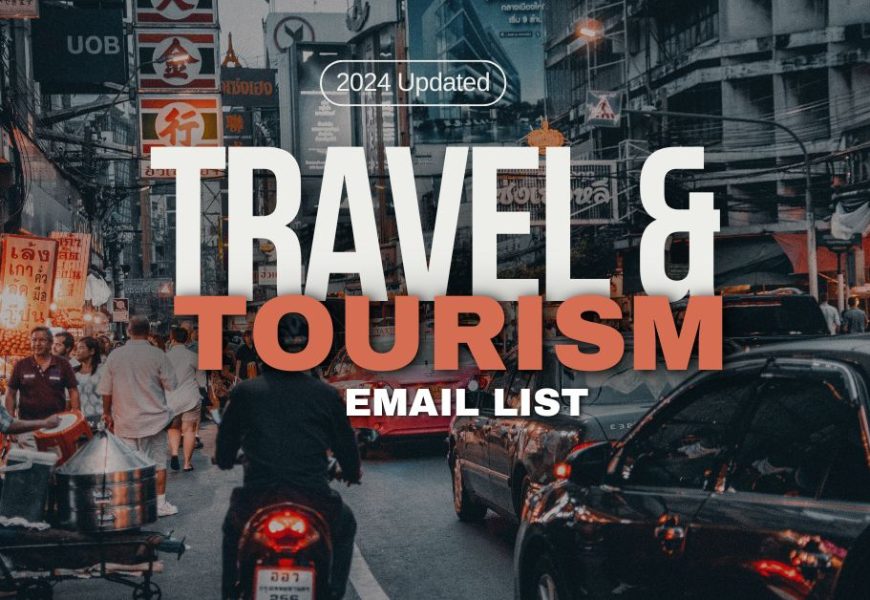Email marketing is one of the most effective ways to connect with audiences, and in the travel and tourism industry, a targeted email list can unlock countless opportunities for engagement and growth. Building or purchasing a well-curated travel and tourism email list allows companies to reach potential travelers with personalized promotions, timely updates, and inspiring content that can motivate them to book their next trip. This guide delves into the essentials of travel and tourism email list, including the benefits, building strategies, and best practices for maintaining high engagement rates.
Understanding the Value of Travel and Tourism Email Lists
Email marketing in the travel industry provides a direct line to customers who are actively interested in receiving updates, deals, and promotions. However, the effectiveness of email campaigns heavily depends on the quality of the email list used. A carefully curated travel and tourism email list is vital for ensuring that marketing efforts reach a receptive audience, leading to higher conversion rates and customer loyalty.
Key Benefits of a Targeted Travel and Tourism Email List
- Increased Engagement: Sending emails to those genuinely interested in travel and tourism leads to better open and click-through rates. A highly targeted list ensures that your message lands in the inbox of those most likely to engage.
- Enhanced Personalization: Knowing who is on your list allows for highly personalized campaigns, such as location-based offers, seasonal travel tips, and special promotions for returning customers.
- Cost Efficiency: Marketing to an audience more likely to convert reduces wasted effort and resources, helping to maximize your return on investment.
Strategies for Building a Travel and Tourism Email List
Building an email list for travel and tourism can be achieved through several methods, from organic growth to purchasing pre-existing lists. Below are some of the most effective strategies to consider:
1. Offer Valuable Content and Promotions
People are more likely to subscribe to a travel email list if there’s a clear benefit. By offering exclusive discounts, travel guides, and useful resources, you can encourage sign-ups. Creating downloadable guides, like a “Top 10 Vacation Destinations of the Year” or “Packing Checklist for Your Next Trip,” can also attract sign-ups from travel enthusiasts.
2. Use Website and Blog Sign-Up Forms
Travel and tourism websites often host blogs with valuable travel tips, destination guides, and seasonal travel recommendations. Use these pages as an opportunity to include strategically placed email sign-up forms. If your readers find the blog content useful, they’re more likely to subscribe to receive similar content and promotions.
3. Incentivize Referrals
Encourage existing subscribers to refer friends and family by offering them incentives like discounts or entries into a sweepstakes. Referral incentives can be an excellent way to grow a travel email list with people who share similar interests in travel.
4. Social Media Promotions
Travel businesses often have significant followings on social media platforms like Instagram, Pinterest, and Facebook. Use these platforms to run promotions and encourage followers to subscribe to your email list for exclusive offers, early booking access, and travel inspiration.
5. Purchase a High-Quality Email List
If you’re looking to quickly expand your reach, purchasing a high-quality travel and tourism email list from a reputable provider can be a valuable option. Ensure that the provider follows data privacy regulations and offers a segmented, updated list that meets your target audience criteria.
Segmenting Your Travel and Tourism Email List
A segmented email list enables more effective targeting and personalization. When you divide your list based on specific criteria, you can send tailored messages to each group, increasing the relevance of your emails. Here are a few common ways to segment a travel and tourism email list:
- Travel Preferences: Segment by interests, such as adventure travel, luxury vacations, or family trips, allowing you to send relevant offers based on individual preferences.
- Location: Use geographical data to offer region-specific deals, such as winter trips to tropical destinations or weekend getaways near the subscriber’s area.
- Past Behavior: Segment based on past actions, like previous bookings, abandoned bookings, or engagement with specific types of content.
Crafting Effective Emails for Your Travel and Tourism Audience
Once you have a targeted list, your focus should shift to creating emails that capture attention and inspire action. Below are some key components of a successful travel and tourism email:
1. Engaging Subject Lines
In a competitive inbox, a compelling subject line can make or break your email’s performance. Craft subject lines that spark curiosity or excitement, such as “Unlock Hidden Gems: Explore Europe’s Best-Kept Secrets!” or “Exclusive 20% Off for Your Next Adventure.”
2. Inspiring Visuals
The travel and tourism industry benefits greatly from visual storytelling. Use high-quality images and videos of popular destinations, enticing accommodations, and thrilling activities to capture the audience’s attention and help them envision their next trip.
3. Clear Call-to-Actions (CTAs)
Every email should have a clear call-to-action that directs readers towards a specific goal, such as “Book Now,” “Learn More,” or “Claim Your Discount.” Place the CTA prominently and make it easy for readers to find and act upon.
4. Personalized Content
Using subscriber data to personalize content can significantly improve engagement. For example, if you know that a subscriber has shown interest in beach destinations, tailor your message to highlight tropical locations and related deals.
Best Practices for Maintaining a Healthy Travel and Tourism Email List
A successful email marketing campaign relies on a clean, up-to-date list. Follow these best practices to maintain a healthy and engaged travel and tourism email list:
1. Regularly Clean Your List
Periodically remove inactive subscribers and hard bounces to keep your list engaged and deliverability high. Sending emails to inactive subscribers can hurt your sender reputation and lead to higher bounce rates.
2. Comply with Data Privacy Regulations
Ensure that your list-building practices and email campaigns comply with data privacy laws like GDPR and CAN-SPAM. Always provide clear opt-out options and respect your subscribers’ preferences to build trust.
3. Test and Optimize Campaigns
A/B test different elements, such as subject lines, CTA placements, and visuals, to see what resonates most with your audience. Analyze campaign metrics to refine and improve your strategy over time.
4. Encourage Engagement
Encourage engagement by including interactive elements, like polls, surveys, and quizzes. You might ask for opinions on upcoming destinations or preferences for travel content, which also helps you gather valuable insights for future campaigns.
Measuring Success: Key Metrics for Travel and Tourism Email Campaigns
To determine the effectiveness of your email marketing, focus on the following key metrics:
- Open Rate: Indicates how well your subject lines and sender name resonate with recipients.
- Click-Through Rate (CTR): Measures the level of engagement and the effectiveness of your CTAs.
- Conversion Rate: Shows how many recipients took the desired action, such as booking a trip or signing up for a loyalty program.
Conclusion
A well-maintained travel and tourism email list can be a game-changer for businesses seeking to engage with potential travelers. Whether you choose to build your list organically or purchase a high-quality, segmented list, having a targeted audience allows for more effective campaigns and greater conversion potential. By focusing on personalized content, segmenting your audience, and adhering to best practices, you can turn your email marketing into a powerful tool that fosters loyalty, drives bookings, and inspires customers to explore new destinations.










